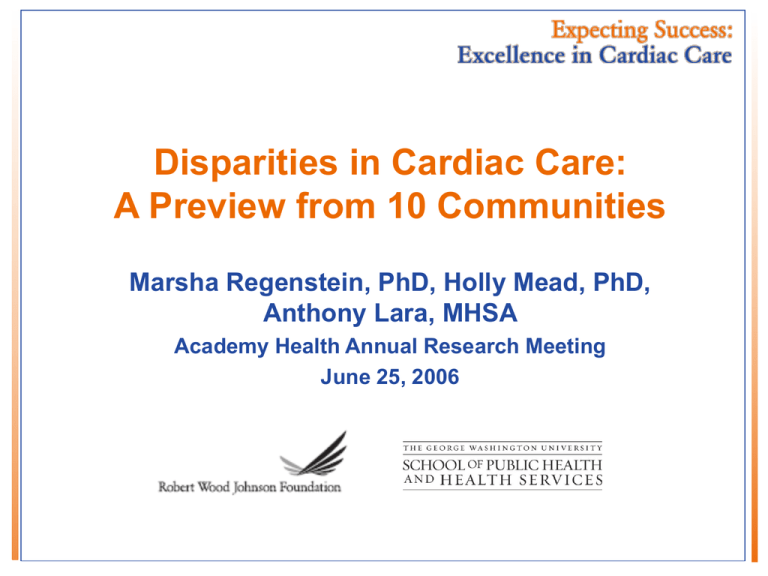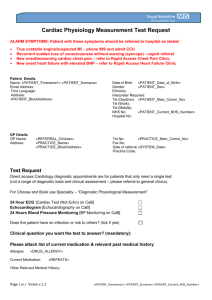Disparities in Cardiac Care: A Preview from 10 Communities Anthony Lara, MHSA
advertisement

Disparities in Cardiac Care: A Preview from 10 Communities Marsha Regenstein, PhD, Holly Mead, PhD, Anthony Lara, MHSA Academy Health Annual Research Meeting June 25, 2006 Expecting Success: Excellence in Cardiac Care National program of RWJF that combines quality improvement work with strategies to reduce disparities associated with the delivery of heart care in U.S. hospitals. 10-hospital learning collaborative over 29 months Cardiovascular market assessments support work of ES: Multiple market factors contribute to minority/ethnic patterns in care that may result in suboptimal care Ultimately, provision of care segmented based on patients’ ability to pay Racial/ethnic disparities result as an outcome of market segmentation 2 Series of products: confidential bulletins for grantees and public reports Expecting Success Sites Mount Sinai Hospital Chicago, IL Montefiore Medical Center New York, NY Sinai-Grace Hospital Detroit, MI Washington Hospital Center Washington, DC Duke University Hospital Durham, NC Del Sol Medical Center El Paso, TX University Health System San Antonio, TX 3 Memorial Regional Hospital Hollywood, FL University of Mississippi Medical Center Jackson, MS Delta Regional Medical Center Greenville, MS CV Bulletins 1: Methodology 4 Two-day site visits to grantee hospitals and other key providers of cardiac care in each community. Interviews with approximately 300 contacts: hospital and health center leaders, cardiologists, primary care physicians, advocates, health department officials, others. Information from U.S. Census Bureau, the Centers for Disease Control and Prevention, local health departments, peer-reviewed literature, local reports. Factor 1: Health Care Financing Business and financial considerations lead to segmented care by insurance coverage and ability to pay. Hospitals, physicians must maintain financial viability in order to fulfill responsibilities Often results in “skimming” phenomenon Well insured patients attracted to facilities that market to this patient population Uninsured, Medicaid populations cluster at facilities known to treat this poorer patient population 5 Minorities affected by skimming due to high proportions of uninsured and Medicaid 6 Factor 2. Market Segmentation Objective – to grow market share by Providing high-end medical care and other amenities Attracting privately insured, Medicare patients who can pay for specialized care May result in racial and ethnic disparities Minorities disproportionately represented among the uninsured and publicly insured Effectively shuts them out of this care Manifested at both the market and hospital level Development of high-end specialty cardiac hospitals Development of floors, suites or other non-clinical amenities 7 Factor 3. Availability of Resources Few hospitals, physicians have sufficient resources to offset the costs of care for the uninsured. Federal, state and local resources to support care for the uninsured include: Federally qualified community health centers (FQHCs) Public hospitals with safety net mandate State or local indigent care programs 8 Without dedicated resources health care providers struggle to meet the cardiac care need of residents Factor 4. Referral Patters Income, insurance status drive the referral process Low-income, uninsured or underinsured patients are referred to the lower tiers of the health care system Privately insured patients are directed to the top tier of the health care system 9 Key referral pathways in heart care Provider to provider referral practices Referral pathways into the Hospital “Front Door” Referral pathway into the Hospital Emergency Department Provider to Provider Referral Relationships By Insurance Coverage 10 Provider to Hospital Referral Pathways By Insurance Coverage: “Front Door” vs. Emergency Department 11 5. Coordination of Cardiac Care Across Multiple Sites and Providers Coordinated cardiac care consists of communication and coordination among primary, specialty, inpatient providers monitoring of patient adherence to treatments tracking referrals Lack of coordinated care can lead to poorer health outcomes Attention to only episodic care Duplication of services Frustration among patients Coordinated cardiac services a challenge for racial and ethnic minorities More likely to lack medical home who can manage disease 12 What Can Hospitals Do to Improve Care for Minority Patients with Heart Disease? 13 Data is power: collect and analyze utilization patterns and outcomes for all patients by race, ethnicity and language Form collaboratives with other community resources (CBOs, hospitals, CHCs, etc) Develop strategies to address challenges facing many minority patients (e.g., access to pharmaceuticals, specialists, care management) Bring health care closer to the community: education, outreach, networks/contacts. Improve coordination of services and shared information across points of care.






